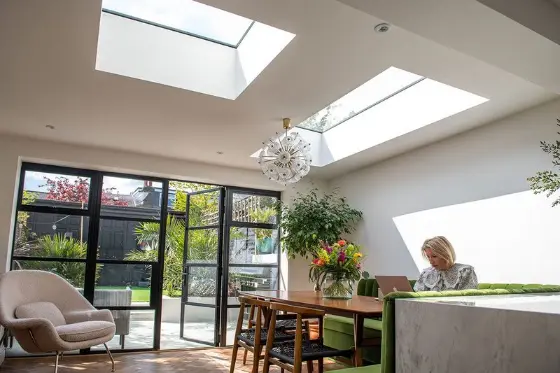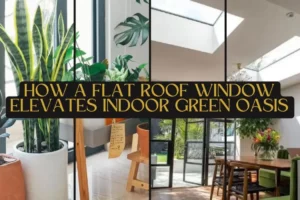Flat roof windows are a game-changer for architects and contractors aiming to enhance indoor gardens. They maximize natural light, efficiently use space, create a seamless indoor-outdoor connection, improve energy efficiency, offer versatile design options, and ensure easy maintenance.
With these benefits, flat roof windows are a fantastic addition to any project, creating a vibrant and sustainable indoor green oasis that will leave clients and occupants inspired and refreshed. If you’re creating beautiful, functional spaces, consider the endless possibilities of flat roof windows in your next project.
What is an Indoor Green Oasis?

An indoor green oasis, often called an indoor garden, represents a carefully planned and nurtured space. The inside of a building is dedicated to cultivating various plants or other greeneries. In addition, these indoor gardens are thoughtfully created to copy the aesthetics and atmosphere of an outdoor garden—featuring an abundance of plants, flowers, and occasionally even trees.
Understanding the Flat Roof Window
A flat roof window, also identified as a roof light or skylight, is a specialized type of window that experts designed for installation on a flat or gently sloping roof to facilitate the infiltration of natural light into the area beneath the roof.
These windows are commonly employed in residential and commercial towers to amplify natural illumination, ventilation, and aesthetic allure. Here are several essential features of flat roof windows:
- Design and Structure: Flat roof windows have a distinctive design that aligns seamlessly with the roof’s surface, producing a sleek, contemporary aesthetic. Typically, they comprise a frame and a glazing unit. They are from toughened or laminated glass affixed to the roof’s exterior.
- Types: There are variations of flat roof windows available, encompassing fixed skylights, operable skylights, pyramid skylights, and lantern skylights. Fixed skylights remain stationary, primarily serving the purpose of letting daylight in, while operable skylights can be manually or electronically opened, affording ventilation in addition to natural light.
- Materials: The frames of flat roof windows are typically from materials such as uPVC, aluminum, or timber. The choice of material significantly affects the window’s longevity, energy efficiency, and visual appeal.
- Glazing Options: The glazing, or glass in flat roof windows, is in diverse configurations, including single, double, or triple glazing. Double or triple glazing enhances insulation and assists in regulating indoor temperatures.
- Ventilation: Certain flat roof windows are purposefully designed to open, giving natural ventilation. Effective ventilation enhances indoor air quality and temperature control within the area below.
Benefits of a Flat Roof Window for Indoor Gardens

Adding flat roof windows to your architectural and construction projects can offer numerous advantages to indoor gardens. Here’s why they’re a smart choice:
1. Maximizing Natural Light
Architects and builders aim to create well-lit indoor spaces that enhance visual appeal and well-being. Flat roof windows are an excellent way to optimize the penetration of natural light strategically, creating a welcoming and dynamic indoor garden.
2. Efficient Space Utilization
Efficient space utilization is crucial in construction. Flat roof windows have a unique advantage in this regard as they don’t consume valuable wall space. This allows walls to be used for storage, art displays, or structural elements—making them a boon for architects and builders looking to maximize available space.
3. Seamless Indoor-Outdoor Connection
Indoor gardens connect to nature, even in urban settings. Flat roof windows like the Fakro DXW flat roof window bridge the gap between interior and exterior, providing an uninterrupted view of the sky. This connection with the outside world can create a calming and refreshing atmosphere, making it a selling point for architects and builders aiming to establish serene environments.
4. Energy Efficiency
In the eco-conscious world, sustainable design is paramount. Flat roof windows are designed with energy efficiency in mind, offering excellent insulation and helping regulate indoor temperatures. This reduces the need for some artificial heating and cooling, which is both environmentally conscious and financially advantageous in the long term.
5. Versatility in Design
Flat roof windows come in various designs to match different architectural styles. Whether your project has a modern, minimalist, or traditional aesthetic, you can find a flat roof window that fits your design vision. Their discreet and streamlined appearance makes them adaptable for various applications.
6. Accessibility for Maintenance
Practicality is valued by architects and builders. Flat roof windows are designed with ease of maintenance in mind, with features like self-cleaning glass and remote-controlled operation, reducing the need for frequent upkeep. This adds value to your projects by minimizing maintenance costs and inconveniences for occupants.
7. Customization for Your Oasis
Crafting an indoor garden is all about customization. You can tailor flat roof windows to your exact requirements, choosing dimensions, contours, and glazing configurations that match your project’s needs. This adaptability allows you to create your green oasis to align with the unique specifications of each space.
Conclusion
Integrating flat roof windows into your projects is wise, as it can fashion a dynamic and eco-friendly indoor green space. If your profession involves crafting attractive and functional environments, considering the versatility of flat roof windows in your future projects is highly recommended. Your clientele will undoubtedly appreciate your forward-looking approach.
